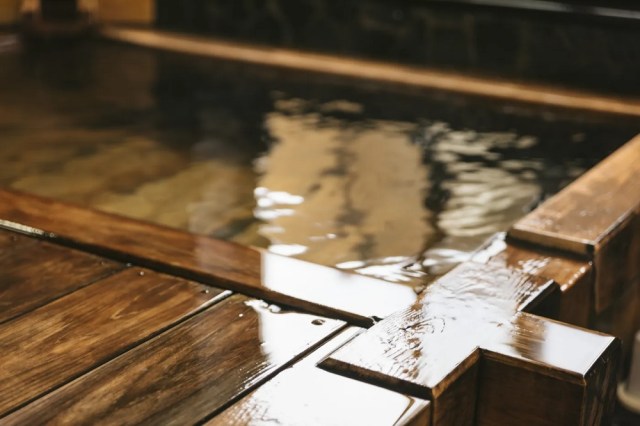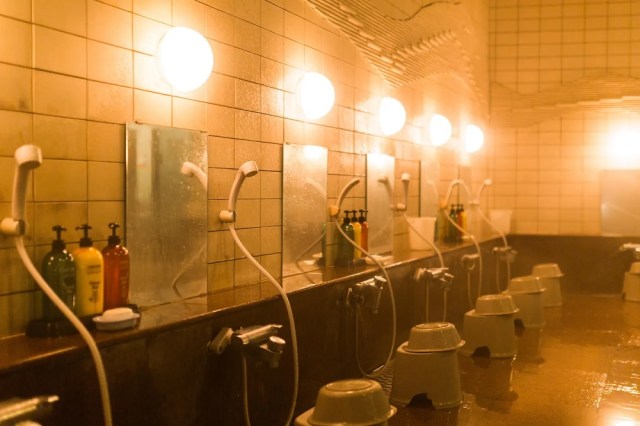
Not all parents are happy with the stricter regulation.
Communal bathing has long been a part of traditional Japanese culture. Mixed-gender bathing, though, or konyoku, as it’s called in Japanese, is something that’s been largely phased out at hot springs and sento (public baths), with the vast majority of such facilities now having two separate bathing areas for male and female customers.
An exception is made for young children though, with Japanese society, for the most part, thinking it’s no big deal for a mother to take her young son into the women’s bath with her, or vice-versa for a father and daughter in the men’s bath. The question is what age qualifies as “young,” there’s now a new legal cutoff in Tokyo.
Previously, children as old as nine were allowed into the bath for the opposite sex, provided they were bathing with a parent or guardian, of course. As of January 1, though, the new age limit is six, meaning that once children hit the age of 7, boys are legally allowed only in the men’s bath, and girls the women’s.
The new ordinance comes in the wake of a survey by Japan’s Ministry of Health, Labor and Welfare last spring which found 6 and 7 to be the ages at which the largest number of children felt embarrassed by being in the bath for the opposite sex. The ministry then recommended that lawmakers revise their jurisdictions’ regulations accordingly, with Tokyo, and a number of other municipalities, making the change at the start of 2022.
As the new policy went into effect, some parents at a public bath in Tokyo’s Higashikurume district weren’t happy about the stricter rules, as shown in the video below. A father who came with his three children, two sons and an eight-year-old daughter, was disappointed that the group won’t all be able to go into the bath together, as was the girl herself.
Another mother worries about sending her son into the men’s bath on his own when he turns 7, and the concern isn’t just about the child’s safety. In Japanese-style bathing, you’re supposed to thoroughly wash your body at a shower station so that you’re completely clean by the time you dip so much as a toe in the communal tub, in order to keep the shared bathwater clean. The mother wonders if a seven-year-old will be able to meet that standard of cleanliness without a parent present to double-check their self-washing skills. A still grubby kid jumping into the tub could cause discomfort for the other bathers as well as problems for the bathhouse’s staff if so much grime is tracked into the tub that it has to be drained and cleaned before customers can get back in.
However, the vast majority of commenters on the video have no problem with the new law, with some saying it doesn’t go far enough.
“Just gonna have to make sure your kids can properly wash themselves by the time they’re 7. That’s part of raising them right.”
“I’m fine with this. There was a startlingly old girl in the men’s bath one time when I went in, and I’m sure a boy that big in the women’s bath would have made them feel uncomfortable too.”
“I think they should make the age limit for being in the opposite sex’s bath even lower.”
“I think 3 or 4 years old should be the max.”
“It’s kind of a difficult question, since there are many kinds of family situations [such as single parents or families where both parents can’t come to the bathhouse at the same time because of work].”
“If it’s such a problem for parents, then they don’t have to come to the public bath in the first place.”
As alluded to by the last comment, though communal bathing was once more or less an unavoidable necessity of life in Japan, in the modern era it’s pretty much an optional way to get clean. Two or three generations ago, it still wasn’t all that unusual for Japanese homes, especially those of working-class families, to lack bathing facilities, meaning family members had to make regular trips to their neighborhood public bath. Nowadays, though, all but the most spartan of apartments have a bath/shower combo, so going to the sento is more a leisure activity than a cornerstone of anyone’s hygiene routine.
That shift in public bath usage habits is likely part of the reason why the age limit has now been changed, and even prior to the new rule going into effect, it was unusual to see nine-year-olds in the opposite sex’s bath. If going to a sento is a purely discretionary choice, then the question of what makes bathers’ time there comfortable and enjoyable becomes more important, and “That kid seems kind of old to be in this bath to me, but maybe he/she doesn’t have any other options” becomes a less likely conclusion.
Sources: Tele Asa News via Yahoo! Japan News via Jin, YouTube/ANNnewsCH
Top image: Pakutaso
Insert image: Pakutaso
● Want to hear about SoraNews24’s latest articles as soon as they’re published? Follow us on Facebook and Twitter!


 Tokyo likely to reduce age limit on kids in opposite-sex public baths, report says
Tokyo likely to reduce age limit on kids in opposite-sex public baths, report says Soup not soap: Japanese public bathhouses surviving by converting into retro-chic cafés
Soup not soap: Japanese public bathhouses surviving by converting into retro-chic cafés How not to bathe at a public bathing facility in Japan
How not to bathe at a public bathing facility in Japan Apartments with no bath or shower rising in popularity among young Tokyoites, report says
Apartments with no bath or shower rising in popularity among young Tokyoites, report says Rub-a-dub-dub and relax in a tub: Survey reveals wintertime bathing habits across Japan
Rub-a-dub-dub and relax in a tub: Survey reveals wintertime bathing habits across Japan Japan’s new difficult-to-drink-from beer glass protects your liver, but it’s a brutal experience
Japan’s new difficult-to-drink-from beer glass protects your liver, but it’s a brutal experience Demon Slayer: Kimetsu no Yaiba gets new roller coaster attractions and food at Universal Studios Japan
Demon Slayer: Kimetsu no Yaiba gets new roller coaster attractions and food at Universal Studios Japan How to order snacks on a Shinkansen bullet train in Japan
How to order snacks on a Shinkansen bullet train in Japan New samurai glasses are Japan’s latest weird must-have souvenir
New samurai glasses are Japan’s latest weird must-have souvenir Hello, cosmetics! Clinique teams up with Hello Kitty this summer for first-time collaboration
Hello, cosmetics! Clinique teams up with Hello Kitty this summer for first-time collaboration High-fashion Totoro cuddle purse is like an elegant stroll in the forest【Photos】
High-fashion Totoro cuddle purse is like an elegant stroll in the forest【Photos】 Burger King Japan suddenly adds Dr. Pepper and Dr. Pepper floats to its menu nationwide
Burger King Japan suddenly adds Dr. Pepper and Dr. Pepper floats to its menu nationwide New Nintendo Lego kit is a beautiful piece of moving pixel art of Mario and Yoshi【Photos】
New Nintendo Lego kit is a beautiful piece of moving pixel art of Mario and Yoshi【Photos】 Japan’s cooling body wipe sheets want to help you beat the heat, but which work and which don’t?
Japan’s cooling body wipe sheets want to help you beat the heat, but which work and which don’t? Nintendo history you can feel – Super NES, N64, and GameCube controllers become capsule toys
Nintendo history you can feel – Super NES, N64, and GameCube controllers become capsule toys “The most Delicious Cup Noodle in history” – Japan’s French Cup Noodle wins our heart【Taste test】
“The most Delicious Cup Noodle in history” – Japan’s French Cup Noodle wins our heart【Taste test】 Starbucks releases a cute Frappuccino and Unicorn Cake…but not in Japan
Starbucks releases a cute Frappuccino and Unicorn Cake…but not in Japan Kyoto Tower mascot termination reveals dark side behind cute Japanese characters
Kyoto Tower mascot termination reveals dark side behind cute Japanese characters McDonald’s Japan’s Soft Twist Tower: A phantom ice cream only sold at select branches
McDonald’s Japan’s Soft Twist Tower: A phantom ice cream only sold at select branches Yabai Ramen: What makes this Japanese ramen so dangerous?
Yabai Ramen: What makes this Japanese ramen so dangerous? Finally! Nintendo Japan expands Switch 8-bit controller sales to everybody, Online member or not
Finally! Nintendo Japan expands Switch 8-bit controller sales to everybody, Online member or not Japanese government wants to build luxury resorts in all national parks for foreign tourists
Japanese government wants to build luxury resorts in all national parks for foreign tourists To combat declining birth rate, Japan to begin offering “Breeding Visas” to foreigners
To combat declining birth rate, Japan to begin offering “Breeding Visas” to foreigners 10 things you should buy at 7-Eleven in Japan
10 things you should buy at 7-Eleven in Japan Studio Ghibli releases anime heroine cosplay dresses that are super comfy to wear
Studio Ghibli releases anime heroine cosplay dresses that are super comfy to wear Woman charged for driving suitcase without a license in Osaka
Woman charged for driving suitcase without a license in Osaka Studio Ghibli unveils My Neighbour Totoro miniature house model
Studio Ghibli unveils My Neighbour Totoro miniature house model Kyoto experiencing problems with foreign tourists not paying for bus fares, but not on purpose
Kyoto experiencing problems with foreign tourists not paying for bus fares, but not on purpose Fighting mild hunger with a Japanese soda that turns into jelly in the stomach【Taste test】
Fighting mild hunger with a Japanese soda that turns into jelly in the stomach【Taste test】 Studio Ghibli’s Howl’s Moving Castle tapestry unveiled in Japan for first time
Studio Ghibli’s Howl’s Moving Castle tapestry unveiled in Japan for first time McDonald’s new Happy Meals offer up cute and practical Sanrio lifestyle goods
McDonald’s new Happy Meals offer up cute and practical Sanrio lifestyle goods Sales of Japan’s most convenient train ticket/shopping payment cards suspended indefinitely
Sales of Japan’s most convenient train ticket/shopping payment cards suspended indefinitely Sold-out Studio Ghibli desktop humidifiers are back so Totoro can help you through the dry season
Sold-out Studio Ghibli desktop humidifiers are back so Totoro can help you through the dry season Japanese government to make first change to romanization spelling rules since the 1950s
Japanese government to make first change to romanization spelling rules since the 1950s Foreigner’s request for help in Tokyo makes us sad for the state of society
Foreigner’s request for help in Tokyo makes us sad for the state of society Ghibli founders Toshio Suzuki and Hayao Miyazaki contribute to Japanese whisky Totoro label design
Ghibli founders Toshio Suzuki and Hayao Miyazaki contribute to Japanese whisky Totoro label design Doraemon found buried at sea as scene from 1993 anime becomes real life【Photos】
Doraemon found buried at sea as scene from 1993 anime becomes real life【Photos】 Tokyo’s most famous Starbucks is closed
Tokyo’s most famous Starbucks is closed Princesses, fruits, and blacksmiths: Study reveals the 30 most unusual family names in Japan
Princesses, fruits, and blacksmiths: Study reveals the 30 most unusual family names in Japan Public baths in Japan add some extra fun with hundreds of rubber duckies
Public baths in Japan add some extra fun with hundreds of rubber duckies Soak in a sand bath in Beppu, Japan’s famous onsen region
Soak in a sand bath in Beppu, Japan’s famous onsen region Love Capybaras? Now you can take a hot bath while watching them bathe!
Love Capybaras? Now you can take a hot bath while watching them bathe! A whole bunch of capybara videos to help ease your presidential election stress【Videos】
A whole bunch of capybara videos to help ease your presidential election stress【Videos】 Bathing with Pokémon? Healing species’ powers tapped for Pokémon Recovery public baths in Japan
Bathing with Pokémon? Healing species’ powers tapped for Pokémon Recovery public baths in Japan Miniature sento bathhouse range is this season’s must-buy gacha capsule toy collection
Miniature sento bathhouse range is this season’s must-buy gacha capsule toy collection Nara hotel with hot spring baths by imperial palace site is a reason to remember the prefecture
Nara hotel with hot spring baths by imperial palace site is a reason to remember the prefecture Do Japanese women check out each other’s lingerie at the hot springs? Survey investigates
Do Japanese women check out each other’s lingerie at the hot springs? Survey investigates Onsen in Nagano will now welcome foreigners with tattoos, as long as they patch ’em up
Onsen in Nagano will now welcome foreigners with tattoos, as long as they patch ’em up Tips from Japan to make your skin extra beautiful! It begins with a bath and…
Tips from Japan to make your skin extra beautiful! It begins with a bath and… How to have a Japanese rotenburo bath experience without leaving your home【Photos】
How to have a Japanese rotenburo bath experience without leaving your home【Photos】 Survey shows one in 20 otaku only takes a bath once a week, prompting disgust and redo
Survey shows one in 20 otaku only takes a bath once a week, prompting disgust and redo
Leave a Reply